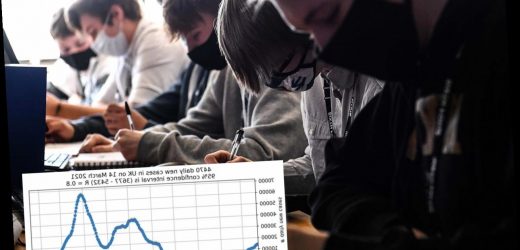COVID cases in the UK have fallen by almost 20 per cent in one week despite schools opening.
According to the ZOE COVID Symptom Study, currently an estimated 4,470 people are falling sick with symptomatic Covid every day.
? Read our coronavirus live blog for the latest news & updates…
The figure compares to 5,494 cases a week ago – a decrease of 18 per cent.
In England alone, 3,226 people are getting Covid each day – down from 4,225.
Opening schools was the first step of lifting lockdowns, so the data bodes well for the next phase.
Schools reopened in England on March 8, and there has been a phased reopening in Wales and Scotland since February 22. But most older pupils are not back in school yet.
In England, it's hoped the groups of up to six can meet in gardens and outdoor organised sport can go ahead from March 29.
Ministers are leaving five weeks between each step of the unlocking so they can assess whether it's safe to move onto the next one.
But the lead scientist of the ZOE Covid study, Professor Tim Spector, said the rate of decline has plateaued in some places.
There are 648 new cases per day in Scotland, up from 592; 424 in Wales, up from 327; and 332 in the North East of England, up from 298.
“This is to be expected after reopening schools across the country and is no reason to worry", Prof Spector said.
“We’re keeping a close eye on cases in school-aged children and so far there’s nothing alarming about the data.
“I believe we'll see case numbers holding steady for a little while before cases drop again.”
One in 1,369 school-aged children in the UK have symptomatic Covid, according to the study data, analysed by researchers at King’s College London.
This does not include children who may be silently carrying the virus with no symptoms.
The Government coronavirus data also reveals that cases have flattened across the UK in the past week.
Some 6,303 new Covid cases were reported yesterday, which is no improvement on the week prior, when reported cases were six per cent higher (5,894).
The seven-day average on March 9 was 5,682, the latest date available, only 1.6 per cent lower than the 5,774 a week prior, on March 2.
However, there has not yet been a huge spike in cases recorded, as feared would happen as a result of students going back to school.
The ZOE app, used by millions of people in the UK and analysed by King’s College London (KCL), has been tracking the outbreak for a year now.
Data reveals cases have fallen by 93 per cent from January – the peak of the second wave when 69,000 people caught the virus per day.
Currently one in 823 people have Covid right now – in January it was estimated one in 50 people in England had the coronavirus.
KCL estimates the R rate in the UK is close to 0.8, similar to the official Government range of 0.6 to 0.8.
But it is estimated to be 1 in Scotland and Wales. An R rate above 1 would mean the outbreak is growing.
It comes after researchers at the London School of Hygiene and Tropical Medicine warned that “close monitoring and evaluation as schools reopen will be crucial to inform ongoing policy”.
Their study revealed that adults who live with a child are more at risk of Covid-19.
Researchers investigated whether the risk of infection and admission to hospital from coronavirus differed between adults living with and without school-age children during the first two waves last year.
They found there was a “small” increased risk of infection and hospital admission for those aged 65 and under who lived with children during the second wave between September and December.
However the peer-reviewed study, which has been published in the BMJ, found it did not lead to an increased risk of death.
Although children can catch the coronavirus, it is very rare for them to become seriously unwell, experts say.
But they do play a role in further spread of the virus, which could mean they give it to relatives they live with.
The LSHTM researchers noted that adults had an increased risk of Covid at a time when schools remained open, raising the possibility that widespread school attendance may have led to increased risks to households.
However, other differences between households could have explained the findings.
Source: Read Full Article










